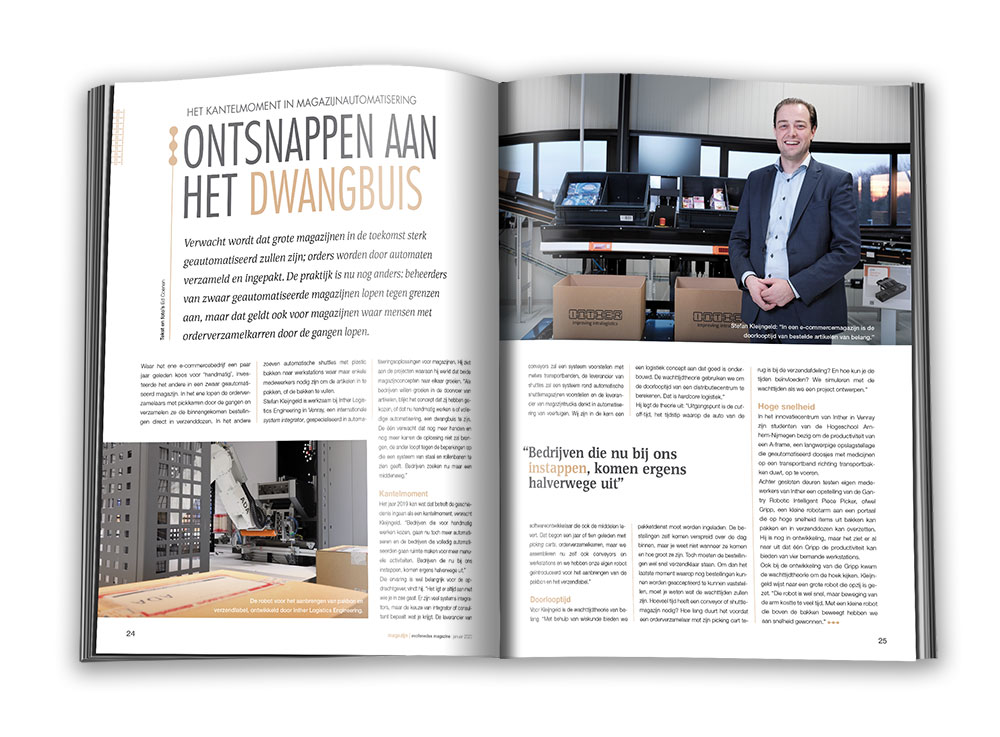11 February 2020
It is expected that large warehouses will be highly automated in the future; orders are collected and packed by vending machines. Practice is now even different: managers of heavily automated warehouses run into limits, but that also applies to warehouses where people with order picking trolleys walk through the corridors.
Escape from the straitjacket
While one e-commerce company opted for “manual” a few years ago, the other invested in a highly automated warehouse. In one, the order pickers walk through the corridors with pick-carts and collect the incoming orders directly in shipping boxes. In the other, automatic shuttles with plastic trays glide to workstations where only a few employees are needed to pack the items or fill the trays. Stefan Kleijngeld – Operations Manager at Inther Group sees from the automation solutions for warehouses that he is working on, that both warehouse concepts are merging. “If companies want to grow in the transit of articles, the concept that they have chosen, whether it is manual work or full automation, turns out to be a straitjacket. One expects that even more hands and more carts will not bring the solution, the other encounters the limitations that a system of steel and roller conveyors presents. Companies are now looking for a middle ground.”
Turning point
In that respect, the year 2019 can go down in history as a turning point, expects Kleijngeld. “Companies that opted for manual work are now going to automate more and the companies that are fully automated will make room for more manual activities. Companies that are joining us now, will end up somewhere halfway. ”That experience is important for the client, he believes. “It always depends on who you work with. There are many system integrators, but the choice of integrator or consultant determines what you get. The supplier of conveyors will propose a system with meters of conveyor belts, the supplier of shuttles will propose a system around automatic shuttle warehouses and the supplier of warehouse trucks thinks in the automation of vehicles. Inther Group is basically a software developer that also supplies the resources. That started about ten years ago with picking carts, order picking carts, but we now also assemble conveyors and workstations ourselves and we have introduced our own robot for applying the packing slip and shipping label. ”
Lead time
The waiting time theory is important for Kleijngeld. “With the help of mathematics, we offer a logistics concept that is well founded. We use the waiting time theory to calculate the lead time of a distribution center. That is hardcore logistics. “He explains the theory:” The starting point is the cut-off time, the time at which the car of the parcel must be loaded. The orders themselves arrive spread over the day, but you do not know when they will arrive and how large they are. However, the orders must be ready for dispatch quickly. In order to determine the last moment at which orders can still be accepted, you must know what the waiting times will be. How much time does a conveyor or shuttle warehouse need? How long does it take for an order picker to return to the shipping department with his picking cart? And how can you influence the times? We simulate the waiting times when we design a project.”
High speed
In the Technology Assembly Center (TAC) of Inther Group, work is underway to increase the productivity of an A-Frame, an elongated storage rack that automatically pushes boxes of medicines onto a conveyor belt towards transport bins. Behind closed doors, employees of Inther are testing a set-up of the Gantry Robotic Intelligent Piece Picker, or GRIPP, a small robot arm on a portal that can retrieve items from bins at high speed and transfer them into shipping boxes. One GRIPP will be able to offer the productivity of four manned workstations. The waiting time theory also came into play during the development of that GRIPP. Kleijngeld points to a large robot that has been set aside. “That robot is fast, but movement of the arm takes too much time. With a small robot that moves above the bins, we have gained enormous speed. ”

